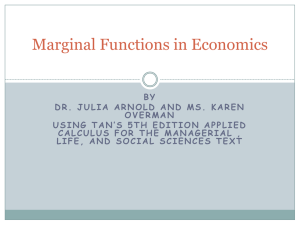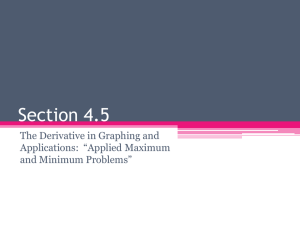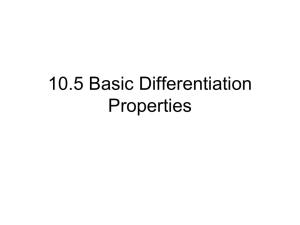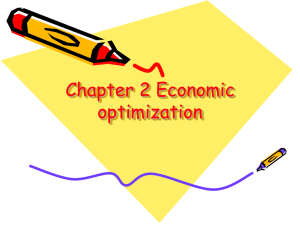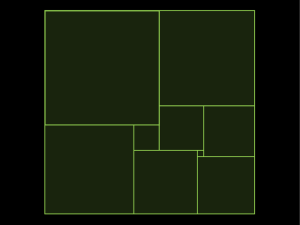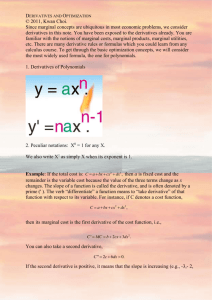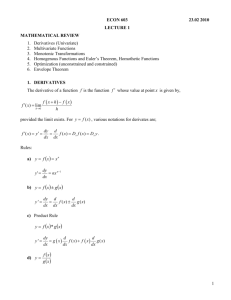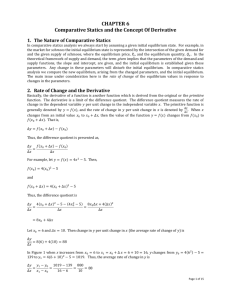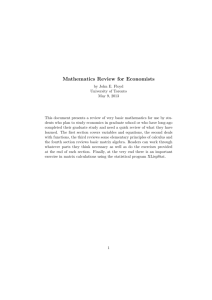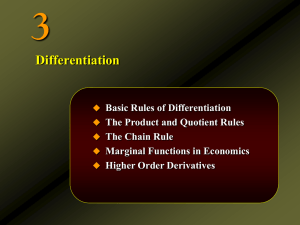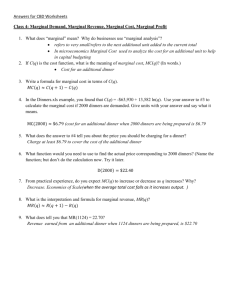Chapter 4.4
advertisement
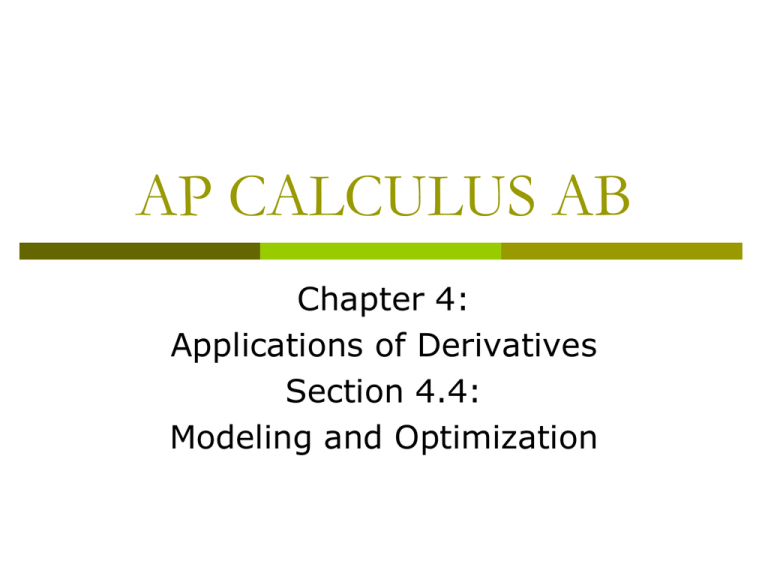
AP CALCULUS AB Chapter 4: Applications of Derivatives Section 4.4: Modeling and Optimization What you’ll learn about Examples from Mathematics Examples from Business and Industry Examples from Economics Modeling Discrete Phenomena with Differentiable Functions …and why Historically, optimization problems were among the earliest applications of what we now call differential calculus. Strategy for Solving Max-Min Problems 1. Understand the Problem Read the problem carefully. Identify the information you need to solve the problem. 2. Develop a Mathematical Model of the Problem Draw pictures and label the parts that are important to the problem. Introduce a variable to represent the quantity to be maximized or minimized. Using that variable, write a function whose extreme value gives the information sought. 3. Graph the function Find the domain of the function. Determine what values of the variable make sense in the problem. 4. Identify the Critical Points and Endpoints Find where the derivative is zero or fails to exist. 5. Solve the Mathematical Model If unsure of the result, support or confirm your solution with another method. 6. Interpret the Solution Translate your mathematical result into the problem setting and decide whether the result makes sense. Example 1: Using the Strategy Find 2 non-negative numbers whose sum is 20 and whose product is as large as possible. What do we want to find? Identify the variables and write 2 equations. Use substitution to get a function to maximize. Simplify, find f ‘, critical points (including endpoints!) Verify max or min value Answer question in sentence You try: Find 2 numbers whose sum is 20 and the sum of their squares is as large as possible. What if we want the sum of the squares as small as possible? Example 2: Inscribing Rectangles A rectangle is to be inscribed under one arch of the sine curve. What is the largest area the rectangle can have, and what dimensions give that area? Let ( x, sin x) be the coordinates of point P and the x-coordinate of Q is ( x). Thus 2 x = length of rectangle and sin x = height of rectangle. A( x) 2 x sin x where 0 x / 2. Notice that A(0) A( / 2) 0. Find the critical values: A '( x) 2sin x 2 x cos x. Let A '( x) 0 and use a graphing calculator to find the solution(s). A '( x) 0 at x 0.71. The area of the rectangle is A(0.71) 1.12, where the length is 1.72 and its height is 0.65. Example 3: Fabricating a Box An open top box is to be made by cutting congruent squares of side length “x” from the corners of a 20 x 25 inch sheet of tin and bending up the sides. How large should the squares be to make the box hold as much as possible? What is the resulting maximum volume? Draw a diagram, label lengths V(x) = length • width • height define length, width, height in terms of x, define domain Solve graphically, Max of V = Zeroes of V’, confirm analytically Take derivative, find critical points, find dimensions (use 2nd derivative test to confirm max and min values) Find volume, answer question in a sentence, including units. Example 4: Designing a Can You have been asked to design a one liter oil can shaped like a right circular cylinder. What dimensions will use the least material? What are we looking for? Given: Volume of can = 1000 cm3 Volume formula: Surface Area formula: Use substitution to write an equation. Solve graphically, confirm analytically. Use 2nd derivative test to confirm min or max. Answer question in a sentence, include units! The one liter can that uses the least amount of material has height equal to ____, radius equal to ______ and a surface area of ____________. You try: What is the smallest perimeter possible for a rectangle whose area is 16 in2, and what are its dimensions? Business Terms and Formulas Business Terms and Formulas: f x Terms x = number of units produced p = price per unit R = total revenue from selling x units C = total cost of producing x units C = the average cost per unit P = total profit from selling Formulas R = xp C C x P=R-C The break-even point is the number of units for which R = C. Marginals Marginals dR MarginalRevenue(extrarevenuefor selling one additionalunit) dx dC MarginalCost (extracost of producingone additionalunit) dx dP MarginalProfit(extraprofitfor selling one additionalunit) dx Examples from Economics Big Ideas r(x) = the revenue from selling x items c(x) = the cost of producing x items p(x) = r(x) – c(x) = the profit from selling x items Marginal Analysis Because differentiable functions are locally linear, we use the marginals to approximate the extra revenue, cost, or profit resulting from selling or producing one more item. We find the marginal analysis by taking the derivative of each function. Theorem 6 Maximum profit (if any) occurs at a production level at which marginal revenue equals marginal cost. p’(x) = r’(x) – c’(x) is used to find the production level at which maximum profit occurs (Theorem 6) Maximum Profit Maximim profit (if any) occurs at a production level at which marginal revenue equals marginal cost. Example Maximizing Profit Suppose that r ( x) 9 x and c( x) x 6 x 15 x, where x represents thousands 3 2 of units. Is there a production level that maximizes profit? If so, what is it? Set r '( x) 9 equal to c '( x) 3 x 12 x 15. 3 x 12 x 15 9 2 2 3 x 12 x 6 0 Use the quadratic equation to find 2 x 2 2 0.586 1 x 2 2 3.414 2 Use a graph to determine that the maximum profit occurs at x 3.414. Theorem 6 Maximizing Profit Maximum profit (if any) occurs at a production level at which marginal revenue equals marginal cost. r’(x) = c’(x) Theorem 7 Minimizing Cost The production level (if any) at which average cost is smallest is a level at which the average cost equals the marginal cost. c’(x) = c(x) / x Example 6: Minimizing Average Cost Suppose c( x) x 6x 15x , where x represents thousands of units. Is there a production level that minimizes average cost? If so, what is it? We want c’(x) = c(x) / x 3 2 Solve for x, Use 2nd derivative test to determine if you’ve found a max or min. Interpret The production level to minimize average cost occurs at x = ____, where x represents thousands of units. Summary - How can we solve an optimization problem? Identify what we want to find and the information we are given to find it. Draw a picture, write equations, use substitution to get a function in terms of the variable needed. Solve graphically, confirm analytically Find max / min points on the graph, don’t forget to consider endpoints. Use 2nd derivative test to confirm max or min. Use the values you’ve found to answer the original question in a sentence. Make sure your answer makes sense!

